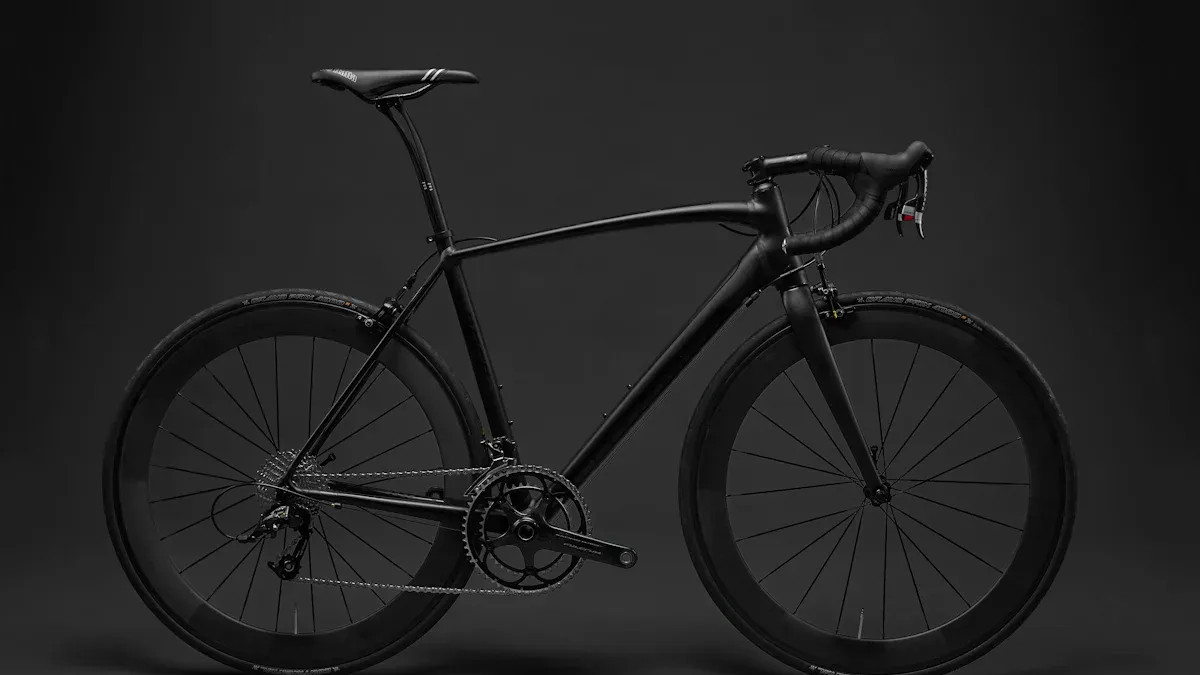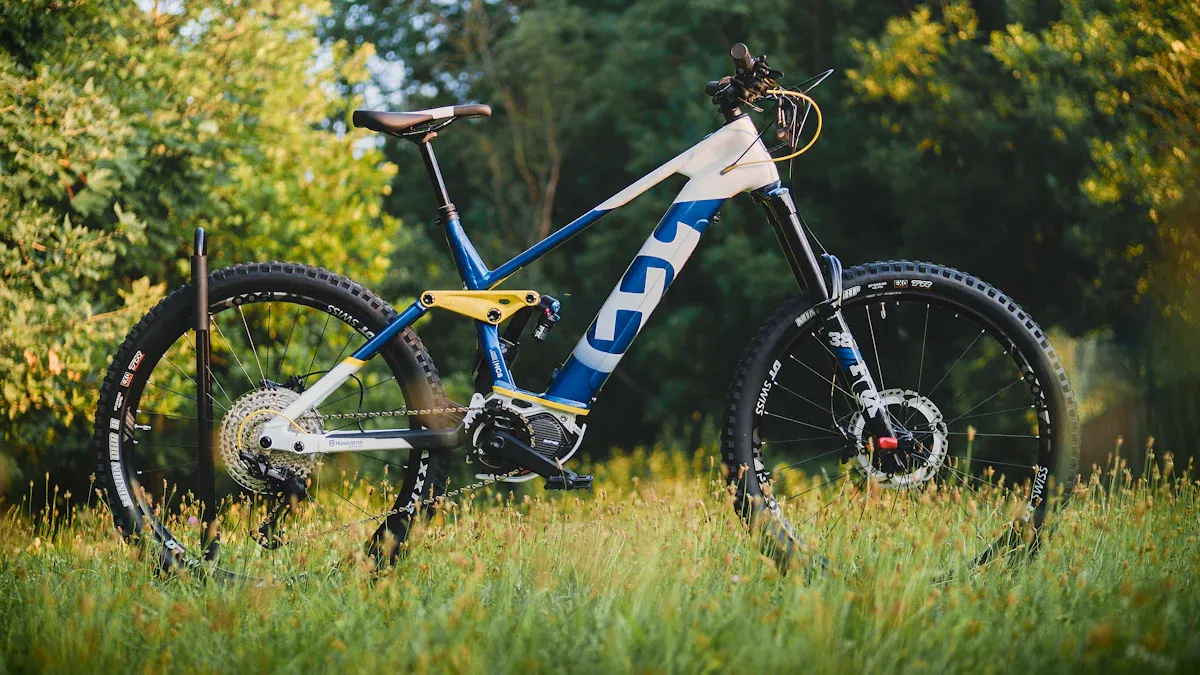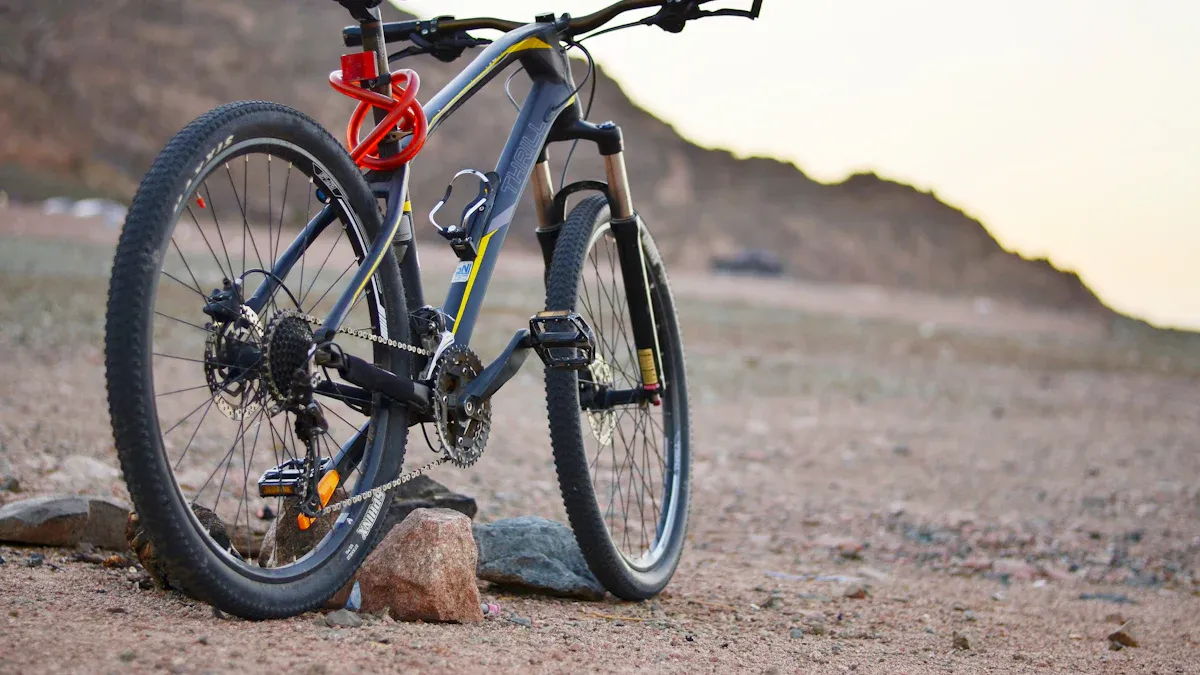
Mountain biking is fun and thrilling. Picking the right mountain bike frame styles is important for your ride. In the last ten years, mountain bike frames have changed a lot. New designs focus on comfort and stability. Features like sloping top tubes are now more popular. Gravel biking has also made older mountain bike frame styles popular again. These older styles work well with wider tires and rougher ground. Knowing these changes helps you choose a frame that fits your riding style. This can improve your performance on the trails.
Key Takeaways
Picking the right mountain bike frame style makes you more comfortable and in control on trails.
Rigid frames are great for casual riders on smooth paths. They are simple and easy to take care of.
Hardtail frames are fast and efficient on smooth trails. They are good for cross-country rides.
Full-suspension frames work well on rough terrain. They absorb bumps and give better stability on tough trails.
Knowing about frame materials like aluminum and carbon fiber helps you choose a bike that fits your budget and riding style.
Mountain Bike Frame Styles
When you pick a mountain bike, knowing the frame styles is very important. Each style has special features for different riding styles and terrains. Let’s look at three main mountain bike frame styles: Rigid, Hardtail, and Full-Suspension.
Rigid Frames
Rigid frames have a simple design. They do not have any suspension system. This makes them light and easy to take care of. Here are some key points about rigid frames:
They offer a comfortable riding position.
They work well on smooth, flat ground.
They are good for riding on both roads and trails.
Rigid frames are great for easy trails. They are perfect for casual riders or those who like a simple biking experience. If you like riding on smooth paths or gravel roads, a rigid frame is a strong and reliable choice.
Hardtail Frames
Hardtail frames have a front suspension fork only. This makes them lighter and simpler than full-suspension frames. This design helps them work well on smooth trails. Here are some important features of hardtail frames:
They are fast and efficient on smooth trails, great for gravel paths and cross-country rides.
No rear suspension helps with speed and climbing.
Common materials like aluminum and carbon fiber balance weight and strength.
Hardtails do well on easier terrains but can feel rough on tough trails. Riders need more skill to stay balanced on bumpy surfaces. If you mostly ride on smooth trails but want to handle some tricky spots, a hardtail frame could be a good fit for you.
Full-Suspension Frames
Full-suspension frames have suspension in the front and back. This makes them great for rough trails. The design of full-suspension frames affects how they perform. Here are some key points:
Design Element | Description |
|---|---|
Affects climbing and going down hills; slacker angles help with going down, steeper angles help with climbing. | |
Seat Tube Angle | Affects how weight is spread; modern bikes have steeper angles for better comfort and efficiency. |
Reach | Affects how the bike fits and handles; longer reach gives more space and better handling. |
Full-suspension bikes are great at absorbing bumps and giving better control on rough ground. They are perfect for riders who take on tough trails and need comfort and stability. If you love downhill rides or tricky trails, getting a full-suspension frame will make your ride better.
Choosing the right mountain bike frame style affects how comfortable and in control you feel on the trails. Each style has its pros and cons, so think about your riding style and the types of trails you want to ride. By knowing these differences, you can pick a frame that fits your needs and improves your overall riding experience.
Cross Country (XC) Bikes

Cross Country (XC) bikes are made for speed and efficiency. They are great for racing and long rides. These bikes are very light, usually under 30 pounds. This helps you climb hills and go fast on flat ground. Here are some main features of XC bikes:
Feature | Description |
|---|---|
Lightweight | XC bikes are made to be light and quick, often under 30 pounds for better efficiency. |
Suspension | Usually has 80mm to 120mm of suspension for smooth rides on different terrains. |
Wheel Size | Often uses 29-inch wheels for better balance and rolling over bumps. |
Frame Geometry | Made for quick handling, helping with faster climbing and speed. |
XC bikes are built for endurance. They work well on hills and downhill, balancing control, stability, and speed. Their light frames allow for fast starts, making them great for racing. Here are some benefits of XC bikes:
Efficiency: XC bikes boost speed with light carbon frames and good drivetrain systems.
Speed: They have quick starts and keep high speeds over long distances.
Climbing Ability: The shape and suspension help with pedaling, making climbs easier.
Adaptability: Their balanced shape gives control and speed, making them good for many races.
XC biking is great for different terrains, including natural and man-made obstacles. These bikes often have shorter tires and suspension to improve performance in various riding conditions. Whether you ride for fun or competition, XC bikes give an exciting experience on the trails.
Trail and All-Mountain Bikes
Trail bikes are very flexible for different riding conditions. They mix cross-country speed with enduro strength. This makes them good for many types of terrain. You can ride them in bike parks or on long trails. Their design makes your ride more enjoyable. Here are some important features of trail bikes:
They have suspension travel from 120mm to 150mm.
Their shape is slacker than XC race bikes, which gives better stability.
Popular models include:
Santa Cruz Tallboy
Ibis Ripley
Specialized Stumpjumper
All-mountain bikes focus more on going downhill. They usually have longer suspension travel, often more than 150mm. This helps them handle rough ground and steep hills. Here’s how trail bikes and all-mountain bikes are different:
Suspension Travel:
Trail bikes: 120mm to 150mm
All-mountain bikes: 150mm and more
Geometry:
Trail bikes: Slacker than XC bikes, made for balance and control.
All-mountain bikes: Even slacker, made for going down hills.
Intended Use:
Trail bikes: Good for mixed terrain and longer rides.
All-mountain bikes: Best for tough downhill riding and tricky trails.
Choosing between trail and all-mountain bikes depends on how you ride. If you like climbing and going down, a trail bike is a good choice. If you enjoy steep hills and rough trails, think about an all-mountain bike. Knowing these differences in mountain bike frame styles helps you make a smart choice.
Enduro and Downhill Bikes

Enduro bikes are made for riders who like tough trails. These bikes mix the best parts of cross-country and downhill bikes. They work well on rough ground and help you climb hills easily. Here are some important design features for enduro bikes:
Rough Trail Capability: Enduro bikes have a longer wheelbase and a slacker head tube angle (about 63-64º). This design makes them more stable when going down steep hills and helps you sit better on the bike.
Downhill Performance: They have DH-inspired parts like 800mm handlebars and 200mm dropper posts. These features help you stay in control and comfortable on hard trails.
Braking Power: Enduro bikes have stronger brakes, bigger rotors, and more powerful pads. This gives you better stopping power in all kinds of conditions.
On the other hand, downhill bikes are made just for going down steep trails fast. They are built to handle very aggressive riding. Here are some special features of downhill bikes:
Feature | Description |
|---|---|
Suspension Travel | 200mm or more of front and rear suspension to soak up big bumps from jumps and rough ground. |
Slack Geometry | A relaxed head angle for stability at high speeds, perfect for steep descents. |
Braking Power | Hydraulic disc brakes give strong, reliable stopping power on tough trails. |
Tires & Wheels | Wide, knobby tires provide grip on loose dirt, rocks, or muddy areas. |
Durable Frame | Stronger, heavier frames built to handle the demands of aggressive riding. |
Enduro bikes usually have 160-180mm of front suspension travel with single crown forks. This setup is lighter and helps with climbing and tight trails. In contrast, downhill bikes have about 200mm of front travel with dual crown forks. This design gives a stiffer connection and a higher front end, making them stable on steep descents.
Choosing between enduro and downhill bikes depends on how you ride. If you like both climbing and going down, an enduro bike is a good choice. If you enjoy steep descents, a downhill bike will help you perform better on those tough trails. Knowing these differences helps you make a smart choice for your next mountain biking adventure.
Frame Material Considerations
When you pick a mountain bike, the frame material is very important. It affects how well the bike performs, how long it lasts, and how much it costs. Here are some common materials used for mountain bike frames:
Steel
Aluminum alloys
Titanium
Carbon fiber
Bamboo
Cardboard
Among these, aluminum and carbon fiber are the most popular. Each material has its own good and bad points.
Aluminum Frames
Aluminum frames are known for being strong and affordable. They are very stiff, which helps you transfer power while riding. Here are some good and bad points about aluminum frames:
Pros:
Cost-Effective: Aluminum frames usually cost less than carbon fiber frames. This makes them a favorite for many riders.
Durability: They handle impacts well, making them good for rough rides.
Weight: Aluminum is lighter than steel, giving you a fast and responsive ride.
Cons:
Fatigue Life: Aluminum frames last about 5 to 10 years. They can crack at the welds over time, especially with heavy use.
Ride Quality: Aluminum is stiff, which can make the ride feel harsher compared to softer materials.
Carbon Fiber Frames
Carbon fiber frames are popular for being very strong and light. Many professional riders use them because of their performance benefits. Here are the pros and cons of carbon fiber frames:
Pros:
Lightweight: Carbon fiber frames weigh less than aluminum, helping you accelerate faster and climb easier.
Stiffness: They have high stiffness, which improves power transfer when turning.
Longevity: With good care, carbon frames can last over 10 years, often longer than aluminum frames.
Cons:
Cost: Carbon fiber frames usually cost more than aluminum frames, which can be a problem for some riders.
Impact Vulnerability: They are strong, but carbon fiber can have hidden cracks after impacts that you might not see right away.
Comparison of Weight and Durability
Here’s a quick look at how aluminum and carbon fiber frames compare in weight and durability:
Material | Weight Comparison | Durability Comparison |
|---|---|---|
Carbon Fiber | Stronger per pound | Much stronger in stress and impact tests |
Aluminum | Heavier | Less durable compared to carbon fiber frames |
Maintenance and Cost Considerations
For maintenance, aluminum frames are usually easier to fix than carbon fiber frames. If an aluminum frame cracks, you can often repair it without replacing the whole frame. On the other hand, fixing carbon fiber can be more complicated and expensive.
In terms of cost, aluminum frames are more affordable, making them great for beginners or casual riders. Carbon fiber frames are pricier, but they offer performance benefits that serious riders may find worth the extra money.
Environmental Impact
You should also think about the environmental impact of these materials. Steel has the least impact on the environment, while carbon fiber has the most due to how it is made. Aluminum and titanium have some impact too, but they can be recycled, which helps reduce their effects.
Knowing the differences between aluminum and carbon fiber frames can help you make a smart choice. Think about your riding style, budget, and how much maintenance you want when picking the right material for your mountain bike frame.
Picking the right mountain bike frame is very important for your ride. Each frame style has special benefits for different terrains and riding styles. Knowing about the materials used in frames can help you make smart choices.
Here’s a quick summary of important things to think about:
Frame Material: Different materials like aluminum and carbon fiber have different weights, strengths, and prices.
Riding Style: Your skills and how you plan to use the bike will help you choose the right frame type.
Comfort and Fit: Make sure the bike feels good for you so you can enjoy your rides.
By thinking about these points, you can pick a mountain bike that improves your performance and fun on the trails. Happy riding! 🚴♂️
FAQ
What is the best mountain bike frame style for beginners?
A hardtail frame is usually the best choice for beginners. It gives a good mix of comfort and control on smooth trails. You can enjoy a light design while learning important riding skills.
How do I choose the right frame size?
To find the right frame size, measure your height and inseam. Most brands have size charts based on these numbers. A good fit makes riding more comfortable and helps with control.
Can I upgrade my bike’s frame later?
Yes, you can change your bike’s frame later. But, think about how it will work with your current parts, like wheels and suspension. Upgrading can boost performance but might cost a lot.
What frame material is best for durability?
Aluminum frames are strong and affordable. Carbon fiber frames are lighter and tougher but can cost more. Pick based on your budget and how you ride.
How often should I inspect my bike frame?
Check your bike frame often, especially before long rides. Look for cracks, dents, or signs of damage. Regular checks help keep your bike safe and working well on the trails.
See Also
Understanding The Differences Between Fat And Mountain Bike Frames
Key Factors To Evaluate When Selecting An E-Mountain Bike Frame
Guidelines For Picking The Perfect Carbon Mountain Bike Frame
Evaluating The Pros And Cons Of Steel Mountain Bike Frames
Understanding The Mechanics Of Mountain Bike Frame Compliance
